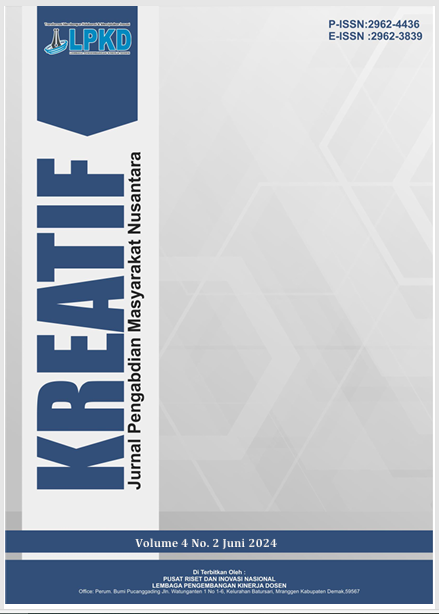Kegiatan Penapisan Kesehatan Mental Mengenai Depresi Pada Kelompok Lanjut Usia
DOI:
https://doi.org/10.55606/kreatif.v4i2.3380Keywords:
Depression, Early Detection, ElderlyAbstract
Depression is a common mental disorder in the elderly, associated with emotional distress, increased health care costs, the risk of suicide, and death from other causes. Depression in the elderly is characterised by persistent sadness, helplessness, anhedonia, changes in appetite, sleep disturbances, psychomotor retardation or agitation, fatigue, impaired concentration, and suicidal ideation. Prevalence varies between 7 and 30%, higher in women. Risk factors include bereavement, social isolation, and somatic diseases, which are more common in old age. Depression increases the risk of dementia, morbidity, and mortality, emphasising the need for early screening. This activity uses the PDCA (Plan-Do-Check-Act) method to screen for depression in 61 elderly participants at the Hana Nursing Home using the Geriatric Depression Scale (GDS) questionnaire. The examination results revealed mild, moderate, and severe depression in 8 people (13.11%), 4 people (6.56%), and 2 people (3.28%), respectively. Early detection using GDS is essential for timely intervention, including counselling and medical advice, to improve quality of life and reduce depression-related morbidity and mortality in the elderly population.
References
Bains, N., & Abdijadid, S. (2024). Major Depressive Disorder. In StatPearls. http://www.ncbi.nlm.nih.gov/pubmed/30396512
Chand, S. P., & Arif, H. (2024). Depression. In StatPearls. http://www.ncbi.nlm.nih.gov/pubmed/0
Firmansyah, Y., & Widjaja, G. (2022). Masalah-Masalah Dalam Kesehatan Jiwa. Cross-Border. https://www.journal.iaisambas.ac.id/index.php/Cross-Border/article/view/1100/877
Hawari, I., et al. (2023). Hubungan Depresi dengan Kejadian Gangguan Kognitif. Journal of Educational Innovation and Public Health, 1(3), 75–85. https://doi.org/10.55606/INNOVATION.V1I3.1496
Hu, T., et al. (2022). Prevalence of depression in older adults: A systematic review and meta-analysis. Psychiatry Research, 311, 114511. https://doi.org/10.1016/j.psychres.2022.114511
Idaiani, S., & Indrawati, L. (2021). Functional status in relation to depression among elderly individuals in Indonesia: a cross-sectional analysis of the Indonesian National Health Survey 2018 among elderly individuals. BMC Public Health, 21(1), 2332. https://doi.org/10.1186/s12889-021-12260-z
Kementerian Kesehatan Republik Indonesia (2018). Laporan Nasional Riskesdas 2018., 146–379.
Krishnamoorthy, Y., Rajaa, S., & Rehman, T. (2020). Diagnostic accuracy of various forms of geriatric depression scale for screening of depression among older adults: Systematic review and meta-analysis. Archives of Gerontology and Geriatrics, 87, 104002. https://doi.org/10.1016/j.archger.2019.104002
Maier, A., et al. (2021). Risk factors and protective factors of depression in older people 65+. A systematic review. Plos One, 16(5), e0251326. https://doi.org/10.1371/journal.pone.0251326
Stone, L. E., Granier, K. L., & Segal, D. L. (2021). Geriatric Depression Scale. In Encyclopedia of Gerontology and Population Aging (pp. 2112–2119). Springer International Publishing. https://doi.org/10.1007/978-3-030-22009-9_736
Wróblewska, I., et al. (2021). The impact of depression on the quality of life in elderly people. Medycyna Ogólna i Nauki o Zdrowiu, 27(2), 199–204. https://doi.org/10.26444/monz/136243
Downloads
Published
How to Cite
Issue
Section
License
Copyright (c) 2024 Susy Olivia, Alexander Halim Santoso, Alicia Herdiman, Yovian Timothy Satyo, Farell Christian Gunaidi, Edwin Destra

This work is licensed under a Creative Commons Attribution-ShareAlike 4.0 International License.








